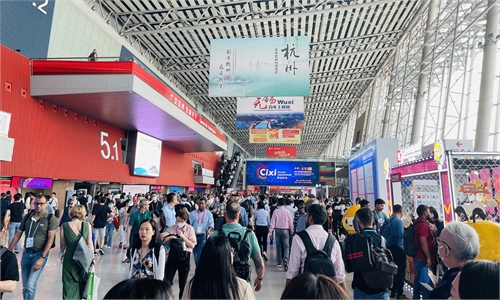
Illustration: Xia Qing/Global Times
With China's green manufacturing showing strong momentum in the world market, the ongoing 133rd China Import and Export Fair, commonly known as the Canton Fair, has also seen great business enthusiasm in green products, which could be one of the brightest spots in future exports helping Chinese manufacturing defy the US' "decoupling" push.The Canton Fair has long been regarded as a bellwether for China's exports. While this year's event just kicked off over the weekend, some Western media outlets like Reuters have already started hyping the alleged exporters' worries about reduced orders.
It is true that the current external environment is indeed complicated, but without any substantive data and solid facts, it remains too early to be pessimistic about China's export performance. If anything, the Western-style pessimism may simply reflect the sinister intentions of talking down the Chinese economy by playing up the uncertainties surrounding the ongoing Canton Fair.
Yet, it is important to note that given the current global economic slowdown, especially in the West, it is understandable that some Chinese exporters may encounter temporary problems, but it doesn't represent the overall picture of China's exports. This is because, even under the circumstances of the current international economic and trade situation, the Chinese exports as a whole has still maintained its relative advantages, for instance, in green products.
And the better-than-expected export figure for March is a prime example as to how the Chinese manufacturing has adapted to the global consumer demand, breaking out of the US supply chain restructuring efforts.
According to data released by China's General Administration of Customs, Chinese exports in yuan terms in March increased by about 23.4 percent from a year earlier, while exports in dollar terms rose about 14.8 percent year-on-year.
An important driver behind China's stronger-than-expected export growth is the robust increase in exports of green products. Specifically, the Chinese exports of electric passenger cars, lithium batteries, and solar cells all posted impressive growth in the first quarter, with the combined exports of the three products up 66.9 percent year-on-year, contributing 2 percentage points to the overall export growth during the first three months of 2023.
Indeed, despite the weak global economy, especially the sluggish performance in some developed countries, China's exports have been characterized with the relatively strong momentum in the trade of green products since 2022.
This edition of the Canton Fair has also reflected the rising trend for China's green manufacturing to enter the world market. About 500,000 green and low-carbon products are on display at the ongoing Canton Fair, ranging from new-energy batteries to clothing and office supplies using green materials and technologies, an indication of Chinese manufacturers eying to open up the global market by shifting toward low-carbon products.
To a certain extent, green trade is likely to become a new growth point for Chinese manufacturing. This is in part because the world is stepping up efforts to combat climate change and reduce emissions, and the global trade will be more closely linked with the transition to a greener global economy, leading to the increasing demand for green products.
According to the Global Trade Update released in March by the UN Conference on Trade and Development, trade of green products reached a record high of $1.9 trillion in 2022, up more than $100 billion compared with the previous year.
On the other side, the Chinese manufacturing is accelerating its green shift by combining new products with low-carbon concepts and technologies. No other place can replace such large-scale green manufacturing that has innovation vitality and follows closely with the global consumption trend.
This is why the US cannot sever the supply chain of Chinese manufacturing from the rest of the world, as even itself cannot completely "decouple" from China's green manufacturing.



